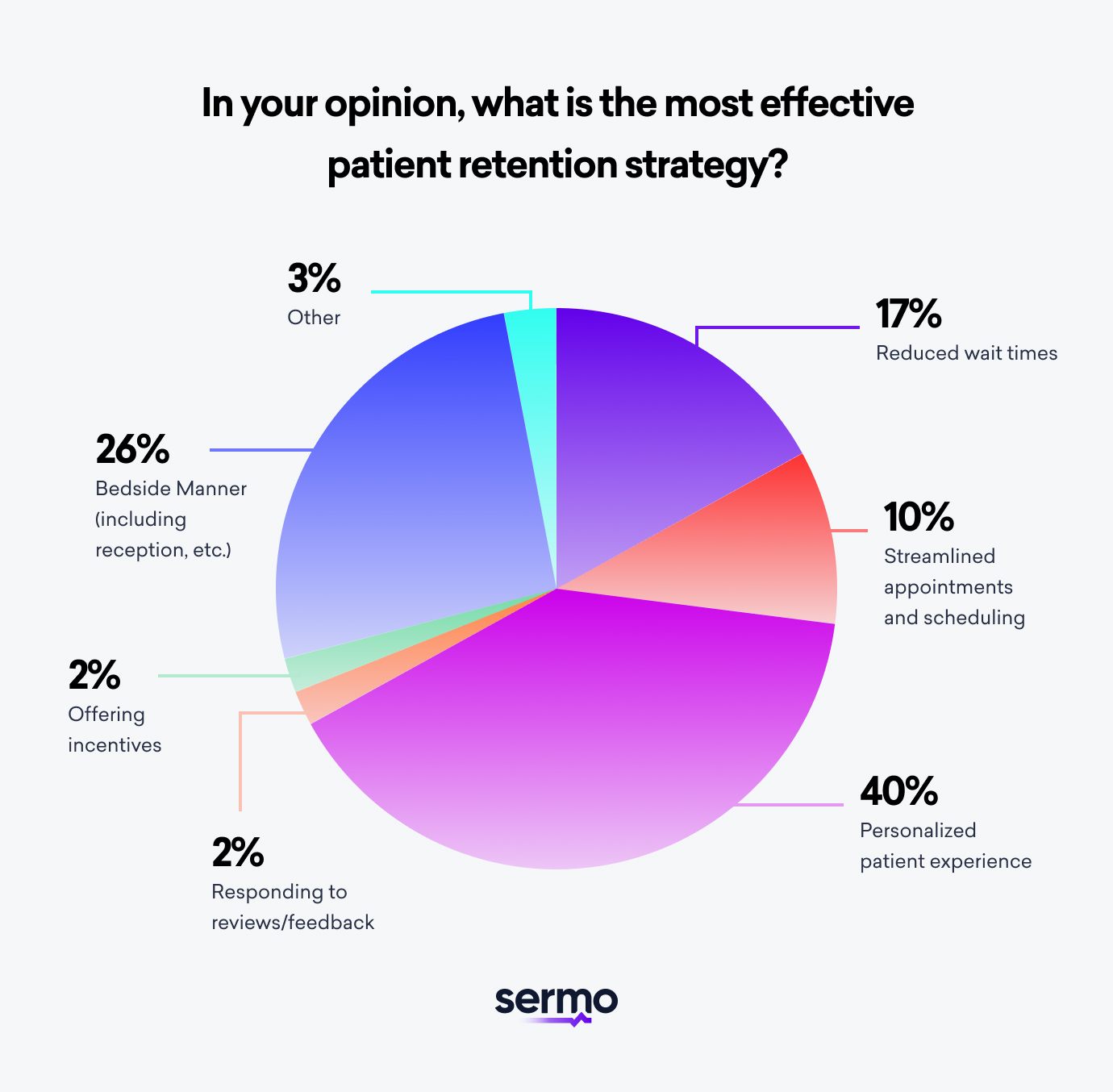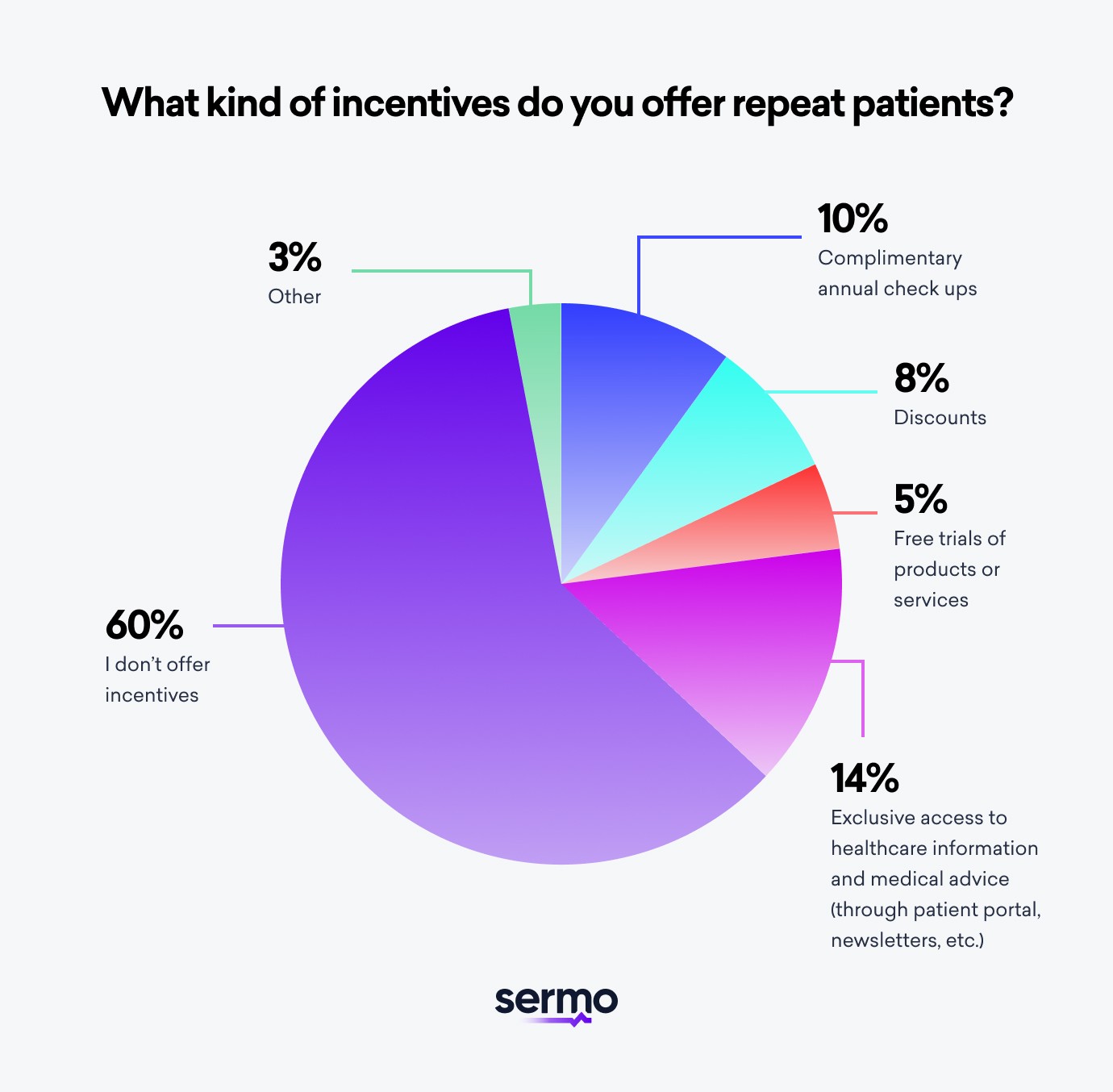
Developing a robust set of patient retention strategies allows you to scale your business and reach profit milestones quicker. Knowing how to get more patients is an essential step. However, it’s equally important – if not more so – to find effective ways to keep patients returning to your practice rather than choosing a competitor for their healthcare needs.
In this guide, we’ll discuss the importance of patient retention in healthcare and provide you with 13 great patient retention ideas that you can use in your practice.
What is patient retention?
As a metric, patient retention is typically expressed as the total percentage of people who return to your practice multiple times. Typically, 60-70% of patients1 stay with their current practitioners. You can use this percentage as a benchmark for your own patient retention.
As a physician, your overall goal is to heal people rather than keep them coming back. However, most patients will need assistance with various injuries and ailments over their lifetime, and many physicians work in fields that involve multiple treatments or conditions that require regular monitoring, evaluation, and follow-up. Proper physician retention strategies ensure these patients stay with your practice throughout their healthcare journey.
“Since Covid-19 pandemic I would say patient retention has reduced, largely in part with the increase of telehealth services that are easily accessible.”
Dermatology, US
Why is patient retention in healthcare important?
Developing strategies for patient retention is essential because research shows it costs 90% less to retain current patients2 than it does to attract new ones. Plus, with long-term patients, the trust you accumulate over time usually translates into a higher spend per visit compared to first-time patients. Cost is a significant factor for all healthcare providers in today’s competitive environment because practices and hospitals are under increasing pressure to cut costs3, which reduces profit margins.
Financial considerations aside, retention strategies in healthcare can also boost your brand image and professional reputation and bring in more new patients through word-of-mouth referrals. Modern-day patients conduct considerable research before selecting or switching their primary healthcare provider. Google receives over 1 billion health-related searches per day4, and review sites like Yelp, ZocDocs, and Web MD empower patients with a wealth of information. So developing healthcare retention strategies that ensure a steady stream of positive online information about you and your practice is vital.
12 patient retention strategies
So, how to get patients to return to your practice? If you’re unsure where to start, this list of top patient retention ideas will help. You don’t necessarily need to use all of them, but it’s a good idea to utilize as many strategies as possible to ensure maximum retention.

1. Train your front desk staff
Your front-of-house staff is often the first human touchpoint for your patients. To keep them coming back for the care they need, your front desk staff needs regular training so they can provide a warm welcome, ample reassurance, and be able to answer patient questions thoroughly. Key topics for training should include customer service, complaint resolution, and product and pricing knowledge.

2. Streamline appointments and scheduling
According to our recent survey, 14% of physicians think making it easy for patients to book appointments is a key patient retention strategy5. Doing so ensures patients can seamlessly schedule the visits they need. Making sure your website is fully functional on desktop and mobile is essential. You should also consider investing in scheduling software that allows you to send:
- Welcome emails
- Appointment reminders via email or text
- Information about which insurance policies are accepted, and the documents patients should bring to their appointments, etc.
This shows your patients that you are professional, organized, and up-to-date with the newest medical practice technology, making it more likely they will return to your practice.
3. Create a positive first impression
Dissatisfied customers tell twice as many people6 about a negative experience as they do about a positive one. So your patient retention strategies should include providing extra touches that make patients feel at ease from their first visit and comfortable about returning in the future. Examples include:
- Providing a welcome drink.
- Offering a practice orientation.
- Make your waiting room as relaxing as possible by incorporating comfortable seating and tasteful artwork.
- Providing free Wi-Fi and phone charging facilities.
- Making exam rooms light, airy, and welcoming
- Providing on-site parking.

4. Reduce wait times
Having patients wait for their appointment is unavoidable, but minimizing wait times goes a long way to reduce anxiety and maximize retention. In fact, 36% of physicians believe reducing patient wait times is one of the most effective retention strategies.
But, what if reducing wait times proves difficult? Research shows that 80% of patients would be less frustrated7 if they knew how long their wait would be. So, even in situations where patient wait time is longer than ideal, you should consider using digital signage with updates on queue status. This has been proven to reduce perceived wait times by up to 35%8. If patients feel their wait time is minimal, they’ll be more likely to come back to your practice next time they need medical help rather than risk waiting longer at a competitor’s office.
5. Personalize patient experiences
Patients want to be seen as individuals, not as an extension of their medical needs. With 44% of physicians noting that a higher level of personalization is key to patient retention, creating experiences that recognize patients as people is essential. Once you’ve invested in the relevant software that allows you to automate and streamline your appointment and scheduling processes, 24% of physicians believe that making a point of personalizing your welcome emails is a top way to improve communication with patients. 30% of survey respondents believe the same is true of personalized appointment reminders. If possible, provide patients with access to an online customer portal where they can view all of their account information. Consider sending out birthday greetings by email or text.
You can also personalize your patients’ in-person visits. Take the time to get to know them on an individual level by asking questions about their lives and memorizing key pieces of information. Always provide a thorough explanation of what you are doing and why, pay close attention to patient needs and questions, and avoid side conversations so they know they have your full focus.
“Nothing beats a good interaction with the doctor – it does not have to be long but it has to be personal.”
Radiology, US
6. Make payments easy
Paying medical bills can be stressful – especially when treatment is urgent or unexpected. Make it clear how payments should be made, and provide full details on how patients can pay using various methods such as Health Savings Accounts (HSAs) and Flexible Savings Accounts (FSAs). If patients are confused about what’s covered under their insurance or how to pay, make sure your staff is familiar with how to check policies and provide the relevant advice. To maximize retention, consider offering monthly payment options so people aren’t tempted to put off their healthcare needs due to financial concerns. Currently, only 56% of our survey respondents noted their practice offers payment options to patients. Clearly, this strategy has room for growth.
7. Ask for feedback
Asking for patient feedback is one of the best patient retention strategies because giving customers a voice shows you genuinely care about their opinions and experiences. Though the feedback requests you send out can take many forms, questionnaires like net promoter score (NPS) surveys9 work well for businesses in the medical sector because they allow you to identify indifferent and unhappy patients that may be at risk of leaving your practice in favor of a competitor. By proactively reaching out before these customers ditch your services or leave a negative review, you can resolve their issues and turn them into loyal return customers. NPS surveys also identify happy patients you can reach out to, knowing referrals and positive reviews will be guaranteed.

8. Improve your website
You might not think your website is relevant to physician retention strategies, as you probably assume that repeat patients wouldn’t need to visit your website after their initial visit. However, it’s unlikely they’ll have your contact details and business information saved after just one consultation. So they’ll likely revisit your website to check your phone number, email address, or hours of operation, etc. Ensure your website is warm, welcoming, and easy to navigate. Where possible, include all of the essential information above the fold (the section showing on the screen when the site first loads) to avoid frustration that could cause website visitors to click away from your site in favor of a competitor website that is more visually appealing or easier to use.
9. Make Search Engine Optimization (SEO) improvements
Because your patients might not remember your website URL, it’s essential they can find your website and business details easily online. To improve your Google rankings and ensure your practice details show up ahead of your competitors, it’s prudent to:
- Have an up-to-date Google Business and Bing listing.
- Update your web copy to include more keywords and improve metadata and alt tags, etc.
- Capitalize on local SEO by including location-based longtail keywords (ex. Chicago IL pediatrician)
10. Respond to reviews
In a Sermo survey, 27% of physicians admitted that they never reply to reviews, and an additional 22% admitted they rarely respond. However, if you want patients to return to you, responding to every review is essential, regardless of whether they are positive or negative. Our best practices for review responses include:
- Personalize your responses instead of ‘cut and pasting’ generic replies.
- Never include information that could violate privacy laws.
- Consult your legal department for advice if you’re ever worried about violating HIPPA10 by responding to a review.

11. Offer incentives
Patients who feel like they are getting something for free are much more likely to be loyal. Offering an incentive to reward patients for their repeat custom is a tried and tested way of getting people to return to your practice. Survey respondents view the following incentives as most important (listed in order):
- A complimentary annual check up
- Cash or percentage discounts
- Exclusive access to healthcare information and advice through your patient portal
- A free trial of one of your products or services
12. Build professional networks
Joining an international professional network provides you with easy access to the global medical community, where you can have discussions with like-minded professionals and seek advice from tenured physicians who have already succeeded in growing their practice by utilizing effective healthcare retention strategies. Sermo’s dedicated physician platform gives you access to more than 1 million verified physicians across 150 countries, many of whom may be able to help with your patient retention strategies.
Retain more patients with Sermo
Boost your professional physician networking efforts and tap into more patient retention ideas by signing up for your Sermo account.
Built by physicians, for physicians, our platform fosters impactful peer-to-peer collaboration and discussions about issues that are important to you and your patients. So you can provide a better overall service, boost your professional reputation, and increase your patient retention simultaneously. Plus, you can showcase your expertise and experience by solving cases and participating in medical studies and surveys – all of which will propel your patient acquisition and retention efforts forward.















